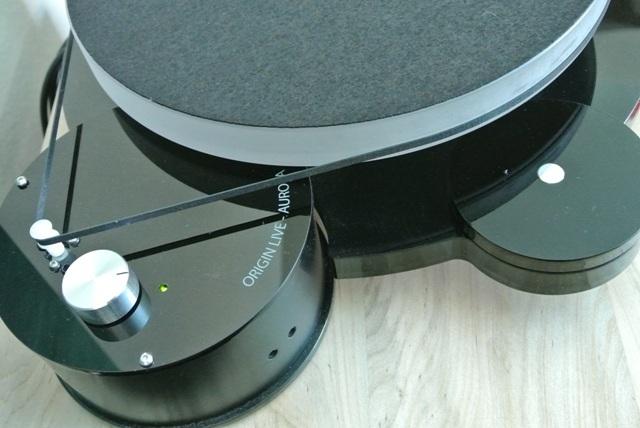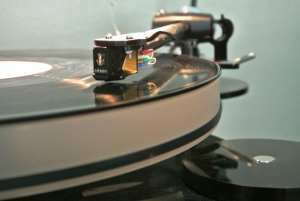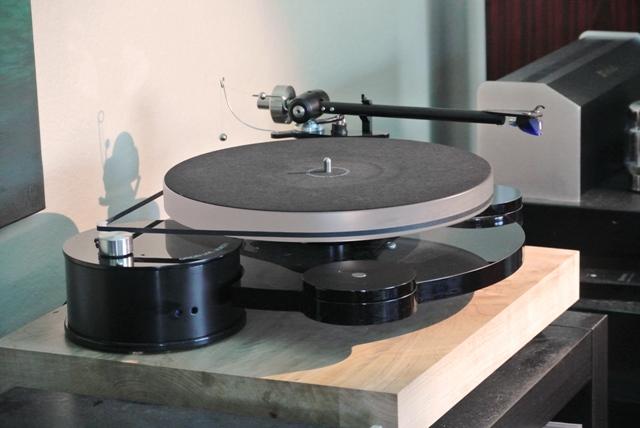Review By TNT Audio
of Origin Live Aurora Mk III – turntable
Product name: Origin Live Aurora Mk III
Manufacturer: Origin Live – UK
Cost: $999 GBP – 1400 USD
Reviewer: Todd Bromgard – TNT USA
Reviewed: October, 2013
Introduction
Mark Baker spent several years as an engineer building ships in the UK. “Naval architecture” is all encompassing and includes multiple disciplines to deal with heat, structure and vibration, explained the affable Baker. However when the industry went into decline in the eighties, he transitioned and followed his passion for tweaking audio components and established Origin Live. Its first products were cable and wire, but in 1992 its isolation stand for the ubiquitous Linn LP12 turntable put OL on the radar of audiophiles. From there Baker expanded into modifications for Rega tone arms, and the company experienced continued growth as its product line-up increased.
Today, Origin Live manufacturers highly regarded turntables, tone arms, phono stages and electronics, all of which are built in house by Mark and his team. The company even carriers its own line of audio racks made of bamboo for the material’s ability to dissipate vibration. OL continues to build upon its success and is about to introduce a line of speakers. However, this review is of Origin Live’s recently released Aurora Mk III deck, it’s the most affordable deck of their line-up.
Description
The Aurora Mk III is a belt driven deck with arm mount. It’s finished in an attractive high gloss black sculpted in low profile semi circles. The look is contemporary and stylish. A 12 inch arm board is optional.
The platter is made of a proprietary material developed for its ability to reduce internal stress. The new precision bearing floats on a film of special OL oil. The sub-chassis is made of a rigid material designed for its low resonance. It sits on 3 leveling feet which are tuned to reduce vibration. The motor is external to further reduce vibration and is described as an ironless DC motor design with no cogging effect.
The power switch is on top of the motor pod next to the spindle which turns the belt. OL made a switch from metal to plastic spindles because the plastic one sounds better even though it is actually more expensive than the metal ones. The belt is handmade to further increase sound quality. OL believes the cumulative effect of the small incremental improvements to the deck add up to a large improvement in overall sound quality.
Previous OL decks used acrylic-type platters without mats; however, the Aurora Mk III comes with OL’s new platter mat. It’s made of a unique proprietary material which was developed over the course of the last 20 years. The new mat can be used on any turntable and is available separately.
The Aurora Mk III deck with mat is available at retailers and direct order from OL for $999. My review sample came with the optional power transformer and venerable Silver Mk IIIA tone arm.
Context
The company’s website states the new deck is able to outperform more expensive decks, even when fitted with less expensive tone arms and cartridges, so I gave it a try. During my time with the Aurora MK III I used the Ortofon 2M Blue, Grado Gold1, Benz ACE L and Dynavector 10×5. Other associated equipment included the Jolida JD9 phono stage, Pass Labs INT-150 integrated amplifier, Rogue Audio Sphinx integrated amp with internal phono stage, Jolida 502 BRC integrated amp, Tekton Enzo speakers, Silverline Prelude Plus speakers, Usher Audio X-718 speakers and Oppo BDP 103 universal player.
The Aurora Mk I deck and Silver Mk III tone arm have served as my personal reference for several years, so I feel particularly qualified to report on the Mk III version.
Set Up
The Aurora Mk III deck took less than 10 minutes to perform initial set-up. It was extremely well packed and all necessary tools, such as Allen wrenches, are included. The instruction manual is very good at explaining how the deck is to be set up and operated. Simply level the sub-chassis on a stable surface, put the oil in the bearing housing, slide the platter assembly into the bearing and top the platter with the mat. It’s that easy.

Origin Live Aurora Mk III – motor
The motor pod sits next to the deck to reduce vibration. The belt wraps around the outer edge of the platter and connects the spindle. Speed is adjustable via screws in the rear of the pod. I used the KAB speed disc and strobe to set speed, an excellent device. Once set, changing between 33 1/3 and 45 is just a flick of the switch, which is nice with the prevalence of audiophile quality 45 rpm coming out. Speed stays true even after a few months. Fit and finish of everything is high quality. My only quibble is the power/speed switch is located a bit too close to the spindle which makes accidental contact with the belt possible if one is not careful.
The Silver IIIA tone arm is a perfect fit for the Aurora Mk III and complements its good looks. The Silver’s base slides into the arm board and is secured via tension bolts, which if over tightened it can have a detrimental effect on the sound. It uses a counter weight at the rear stub, and anti-skate is performed via 2 round weights connected with monofilament fishing line. As the arm moves inward toward the inner grooves of the LP, tension on the line increases and creates stronger anti skate force.
I set the Aurora MK III on a 4″ maple platform with feet, which sits on my record shelf. The Aurora is easy to set up and get great sound, but as in most things in high end audio, it can be significantly improved upon through careful attention to details such as motor pod placement, VTA adjustment and tension bolts.
I read a review of one of Origin Live’s arms, I don’t recall which arm or which publication, but it mentioned there was not much room to maneuver the arm lift lever. When I first received the deck and set up the arm, the arm lift lever could not be used at all because there simply was not enough room to lift the lever. However, careful inspection revealed a small Allan screw which can be loosened to adjust the lever, thus providing plenty of room to maneuver it. It took about 2 minutes to perform the adjustment.
Listening
I placed Alison Krause and Union Station: Paper Airplane on the platter and turned the power to 33 1/3. My first thought: this thing is quiet. Music began to emerge from a silent background as if from a master tape. The soundstage was three dimensional, as if Alison Krause was on stage in the middle of my living room. The Mk III created a proverbial window into the recorded performance. Some decks I have heard produce an exaggerated sound stage with the performers sounding like they’re 20 feet tall. The sound I heard from the Aurora Mk III was more like real instruments playing in three dimensions.
The Aurora Mk III has no suspension. Decks without suspensions run the risk of transmitting unwanted vibrations to the amp and speakers. Not so with the Aurora, with the volume turned up I examined to woofers for excessive pumping and there was none. The deck seems very well isolated.
I played Calexico: Spiritoso, which was purchased on Record Store Day 2013. Spiritoso is a compilation of live recordings accompanied by a full Orchestra and is a must have for any fan. The LP cover has a picture of one of the venues and it looks cavernous. The sense of air and space in the recording is evident. The MK III portrays all of the immediacy of live music.
I was truly amazed at the performance I was getting out of the deck, and it was loaded with the Ortofon 2M Blue, a $225 MM cartridge. The Blue is very nice and a great bargain but its not the last word in definition or transparency. The Mk III deck and Silver arm absolutely squeezed the last drop of performance from the diminutive 2M Blue and the sound was impressive.
I switched cartridges to the recently revised Grado Gold 1 and got great results too. The Gold1 produced a credible soundstage and had a natural tone particularly with female vocals and piano. Norah Jones: Come Away with Me was detailed and natural. The Gold1 also tracked very well and loud passages were no problem.

On well recorded LPs, I prefer the Blue’s presentation; however, the majority of recordings I listen to are not recorded well. The Gold1 is a tad warm, which made LPs like The Rolling Stones: Exile on Main Street much more enjoyable. I went through my record collection pulling out favorite LPs I hadn’t played in a while, which I think is an indication of an audio components’ worth. After all, if your stereo doesn’t make you want to listen to music, why bother having a stereo. The Mk III deck made me want to listen to music the more I played it.
The Benz ACE is a more sophisticated and more expensive cartridge than either the Ortofon or Grado. The Aurora MK III provided ample support and allowed all of the midrange detail for which the Benz is known to come through. I recently attended T.H.E. Show in Newport Beach, California and heard a lot of expensive systems. The ones that sounded good all shared the ability to reproduce midrange that sounded full and natural. The results I heard from the Benz/Aurora Mk III combo rivals the sound I heard at T.H.E. Show coming from the best systems.
I installed the Dynavector 10×5 and pulled out an old favorite, The Cowboy Junkies: Trinity Sessions. I have a first pressing in near mint condition. I acquired it new after seeing the band live at The Coach House in San Juan Capistrano back in 1988. The music was recorded in Canada at the Church of the Holy Trinity with the band circled around a single microphone. When the first song Mining for Gold starts, just before the music begins, the Aurora conveyed the silence and empty space inside the Church. Then, when Margo Timmons begins to sing, the boundaries of walls inside of the Church are defined and the recording venue was suddenly inside my living room.
Compared to the Benz, the Dynavector 10×5 seemed to have a slight emphasis in the upper frequency and more of an up front presentation than the Benz. The 10×5 gave the impression of being closer to the stage than the Benz and also increased the sense of space between instruments.
The Aurora Mk III allowed me to hear the differences between the various cartridges. I wish I had more sophisticated cartridges to play on the Aurora MKIII/Silver combo, I’m sure it would provide proper support for much more sophisticated and expensive cartridges, but I was amazed I was getting such good results with so called budget cartridges.
I played a variety of LPs with the Aurora Mk III and regardless of the cartridge or associated equipment the deck always conveyed the essence of the music. I listened to vinyl from Madeleine Peyroux, Yma Sumac, Beethoven, Charlie Parker, Led Zeppelin, The Band, White Zombie, Fun and many others, and the Aurora never failed to communicate the immediacy of music, regardless of genre. Music played over this deck is compelling and enjoyable, as it should be.
Nearly all of my listening was done using the optional power transformer instead of the supplied wall wart. It is a significant upgrade to the sound of the deck and should be considered mandatory for only $180. Plus it can be used on other OL decks, so if you move up the OL line-up you don’t need a new power transformer. However, it can be added at anytime, so if funds are tight use the wall wart and wait until you can afford it.
The Aurora MK III is more dynamic than other decks I have owned. The highs and lows were more extended than I was used to hearing. The bass was defined and I could tell separate distinct notes were being playing. Vocals were defined but natural. My Mk I is no slouch in the PRAT department. The Mk III is clearly from the same lineage as the MK I, but the MK III clearly sounded better in every way. The improvements over the Aurora MK I were noticeable immediately but the more I listened the more I came to appreciate the Mk III was really in a whole different league.
Conclusion
With the resurgence of vinyl many are looking for their first high end deck. The Aurora Mk III offers far more than entry level sound at a near entry level price. It works well with a variety of cartridges, even inexpensive ones, extracting every last bit of performance possible. I once heard someone say, “If I owned a $3000 cartridge I would be afraid to play a record.” The good news is the Aurora does not require a $3000 cartridge to sound great. Coupled with the OL Silver MK IIIA tone arm and a budget cartridge I could be happy to live with it long term. It offers true high end sound at a reasonable price and has the ability to transport the recorded performance into your listening. I cannot part with it, so I purchased the review sample. Keep up the good work OL.
Reviewer: Todd Bromgard – TNT USA
Reviewed: October, 2013
